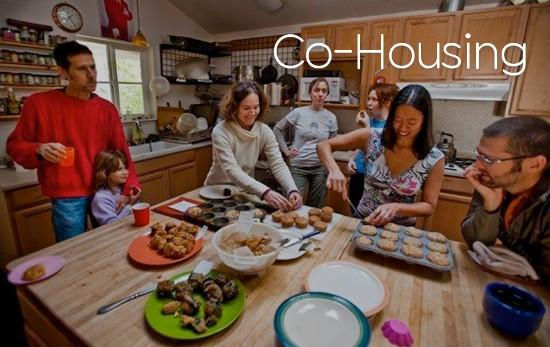
Many individuals are unable to afford their first home until they are well into their thirties. Housing costs are soaring while wages are not rising to compete. Crime, poverty, stress, and social isolation creare disillusionment among many within society. Many are opting to solve these problems by living with like minded people in communities that embrace innovative, less expensive, and regenerative ways of life. Shared communities are becoming popular but what are these communities like? How might they benefit our society and mental health?
What is an Ecovillage?
The Global Ecovillage Network defines An ecovillage is an intentional, traditional or urban community that is consciously designed through locally owned participatory processes in all four dimensions of sustainability (social, culture, ecology and economy) to regenerate social and natural environments.
What they are not:
Ecovillages are not designed by outside developers, architects or experts, but by communities themselves.
Ecovillages are not islands for the rich and middle class
Some of the most vulnerable and marginalized communities are Not marginalized in Ecovillages.
Ecovillages are never considered static. They are always evolving.
What is a Commune?
A “commune,” is an intentional group of folks living together, sharing common interests, property, possessions, resources, work and income. They are encouraged to give up their individuality for the well being and love of the group. They are like minded people that have a goal of reaching others to join them in unity, portraying all others as outsiders. They are often times seen as Religious Cults.
A “community, ” (think Amish) is a group of folks that are like minded, but remain as individuals. They do not share their income, but do share their resources and talents within the group. Some are Religious, some are not. Their goal is to live in harmony with each other and extend their talents to others outside of the group also. They are not seen as a cult. They are very kind hearted and have an amazing gift of works that involves helping one another.
Intentional Communities
An intentional community is a planned residential community designed from the start to have a high degree of social cohesion and teamwork. The members of an intentional community typically hold a common social, political, religious, or spiritual vision and often follow an alternative lifestyle.
Three common structural frameworks common in all of these community types social/diplomatic, economic/method of trade, and ecological/agricultural. In other words there is a method of agreed upon social interaction and order, an agreed upon means of transaction for necessities and a means of necessity production (mainly food & access natural resources).

Agriculture/Food
From my research most of the communities give an option to grow your own food, participate in a community farm or buy food from outside sources. Most community dwellers prefer to produce organic food as part of off grid self sustaining living. The most common and innovative farming types are permaculture, veganic and organic.
Permaculture gardening means "permanent agriculture" and it is defined as working with natural forces—the wind, the sun, and water—to provide food, shelter, water, and everything else your garden needs besides plants and seeds. ... Simply put, Permaculture gardening is a holistic approach life gardening.
7 steps : https://www.hobbyfarms.com/7-steps-to-create-a-permaculture-garden/
12 principles
Observe and interact.
Catch and store energy.
Obtain a yield.
Apply self-regulation and accept feedback.
Use and value renewable resources and services.
Produce no waste.
Design from patterns to details.
Integrate rather than segregate.
Use small and slow solutions.
Use and value diversity.
Use edges and value the marginal.
Creatively use and respond to change.
Organic agriculture
'Organic food is the product of a farming system which avoids the use of man-made fertilizers, pesticides; growth regulators and livestock feed additives. Irradiation and the use of genetically modified organisms (GMOs) or products produced from or by GMOs are generally prohibited by organic legislation.
The Four Organic Principles identified are: Health, Ecology, Fairness, and Care. This is what the pioneers of organic were working towards, as well as what present-day organic farmers and eaters strive to achieve: more of these four qualities encouraged on our planet.
Veganic Farming takes organic farming one step further. It implements organic standards, using little to no pesticides, without the inputs of animal products like manure, blood meal, bonemeal or fishmeal products.
Positive Impact on Mental Health
Evidence suggests that Organic, Veganic and permaculture produces mineral rich vegetables and livestock. The food produced is free of pesticides and harmful chemicals aiding in the pure absorption of vitamins and minerals needed for healthy brain function, circulatory function and mood regulation.
Farming is a form of Horticulture therapy. Horticulture therapy is a therapy of creating, working and engagement of a person in gardening and plant-based activities. Through this, individuals can work on unwanted emotions through the act of gardening, or continuing gardening/ working with plants at home.

Common Economic Structures
Independent Money with Loosely Shared Expenses
For the community, it’s much simpler if its financial focus is narrowly defined: the group will manage the collective assets and liabilities (such as property taxes, infrastructure, and common facilities) and member households will manage themselves. Not only does this protect individual privacy (getting the right balance between group and individual can be tricky) but it’s less work. Members may do a fair bit of expense-sharing and collective purchasing, but the group’s interest in member finances tends to be limited to whether the checks for HOA dues clear and members don’t default on their mortgages.
To be sure, if a member gets into financial trouble, the group may rally around them—either collectively or as neighbors—but it isn’t obliged to.
Complete Community Sharing
In this economic model, the community takes primary responsibility for the economic welfare of its members. In consequence, most such communities roll up their sleeves and develop community-owned businesses, and take advantage of collective purchasing power to leverage economies of scale to make ends meet. In addition to the day-to-day, this kind of community also provides for member vacations, health care, and retirement.
non-income-sharing communities to develop their potential as an economic engine.
Positive Impact on Mental Health
Inclusivity, self esteem, skill development, and social engagement.
Possible Negative impact on Mental Health
Conflict amongst members concerning money can cause isolation for members who may suffer from mental illness. Depression and social anxiety can develop based on negative interactions. Also, mood swings may cause strained interactions or avoidance of engagement.
Intentional Governance
We discussed the basic social composition differences of eco, communal, and intentional communities but how are they governed? How are offenses and conflicts handled? Who decides on community regulations?
During my research on intentional communities, I found that no matter the type of community, their methods of governance were remarkably similar.
Typically these communities are based on egalitarian thought. They view each member of the community as a valuable individual of the community even if not a full member. Provisional membership is granted with limited input in governance until full membership is offered after a trial period. Membership is usually applied for by members being invited for a visit and community events, and voted on by community leaders. Character and background criminal history is assessed closer than economic success.
Many intentional communities, eco villages and communes are secular but there are a few christian and religious based communities. Some religious based communities may be hierarchical but research shows that only 9% of any type of intentional community reportedly operates with hierarchical system. Most intentional communities reject mainstream capitalism and model anarchial, socialist, or communist type systems of governance.
Positive Impact on Mental Health
Emotional distress related to collective surveillance is diminished as individuality and autonomy limits stress. Egalitarian societies enable freedom and equality. Freedom of expression, and lack of social discrimination creates positive psychosomatic neurological function such as an increase in dopamine and serotonin. Healthy Neurological function decreases symptoms such as Psychosis in those that suffer from schizophrenia.
Shared living is a new way of life that may provide an answer to many of society's problems. It may be our future way of living.
I
f this article has given you insight and you would like to seek therapy contact MindBeingWell at +1 (678) 250-3093 or go to our website at welltherapy.healthcare.
My Blog and Vlogs are independent informative articles. Any donations given to show that you enjoyed the information are appreciated !
MindBeingWell Mental Health & Wellness
+1 (678) 250-3093
FB @ innovativementalhealth
pinterest: MindBeingWell Mental Health & Wellness
Comments